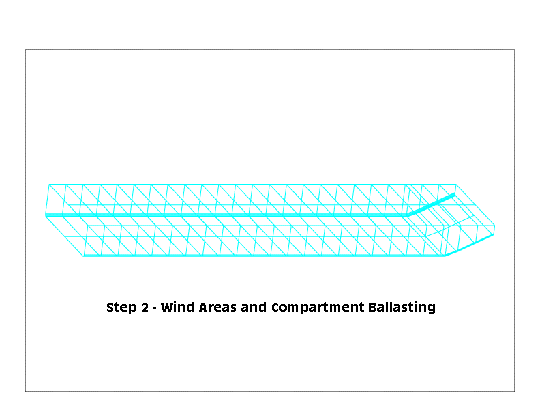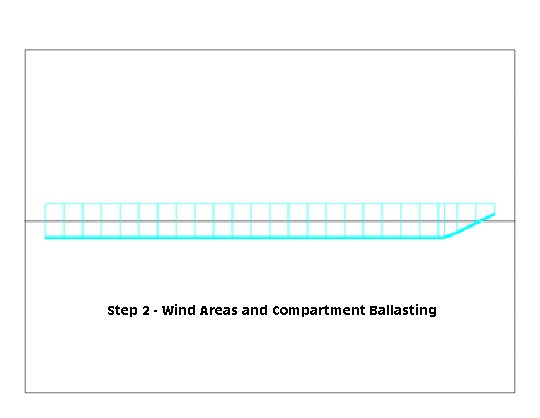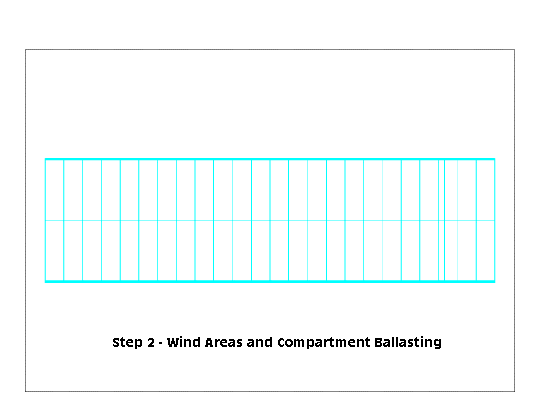Most of our examples contain a common set of "beginning" commands as well as a common "ending" command. Click here to get documentation for these commands. They will not be discussed directly. The files which are discussed here are:
The first basic change which was made was to add the three commands:
&PICTURE ISO
&PICTURE STARBOARD
&PICTURE TOP
after the &INSTATE command. This
will produce three different views of the vessel model.



(For details, click here.) The final change made to the com file was to replace the &WEIGHT command with the two commands:
&STATUS COMPARTM
&SELECT :ALL -SELECT @
&CMP_BAL CBRG180 :ALL
&STATUS B_W
The first of these tells the program to produce a report of the current status of the compartments. In the log file you can see the results of this command. (For details, click here.) The second command creates a selector with a name :ALL. Here the selector :ALL uses the wild card @. The term wild card is defined as any value that can be used will be used. The command &CMP_BAL tells the program to fill or empty the compartments until the vessel is in equilibrium at the current condition, or until the number of iterations is exceeded. The required data after the command is the body name (CBRG180) and the compartment names to be ballasted. Here, we use the selector :ALL. Since the select :ALL used the wild card, all the tanks will be used for ballast. After the program has finished calculating, it shows us the results in the log file. (For details, click here.)
A comparison of the reports obtained with &STATUS B_W for this run and the previous one show what has changed. The total displacement of the vessel is the same as before, 3753 Kips, since we have not changed the shape of the vessel. Also, since we asked for equilibrium in the same condition, the total weight did not change. The vertical center of gravity and the radii of gyration are, however, are different. The effect of the differences in weight and center of gravity will manifest themselves as differences in the righting arms.
Now let us turn to the wind problem. Here, we have changed the data file to define some wind areas. In particular, we add the lines:
&set v_cur = 1
&set v_win = 1
Remember we are using the barge CBRG180 from the vessels library. By default
no wind or drag attractors are included in these models. By defining the two variables,
v_cur and v_win, we turn on the wind and drag attractors for the hull shape.
You can read more about the vessel library
here.
The righting arm report in the output file also reflects these changes. Now that we have turned on the wind attractor the heeling arm, wind arm, is no longer zero. Now let's turn to the remainder of the report. Let us assume our task is to check the area ratio, at the "end of the curve", is larger than 1.4. By "end of the curve", we mean when the vessel has lost effective stability. This loss of stability can occur two ways: the heeling arm can be greater than the righting arm, or the vessel can flood through a vent. The second zero of the net arm is when the vessel has lost stability due to wind. Notice in the report that the net arm has a zero between a roll of 0 and 2.5 degrees, this is the first intercept. The value does not change signs again, so we can conclude that the second intercept does not occur between roll values of 2.5 and 22.5 degrees. Also, notice that the minimum height of the downflooding points is always zero! We have a barge with no vents which will never flood. From what we know now, we can not really pass judgement on stability because 22.5 degrees is normally not a large enough range. To complete the analysis, we should perform the analysis again and increase the total number of roll entries.
